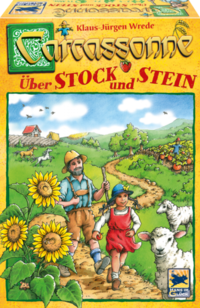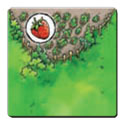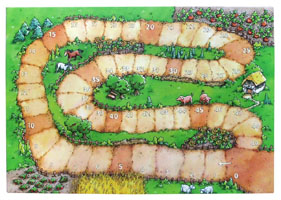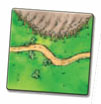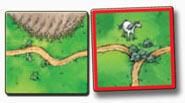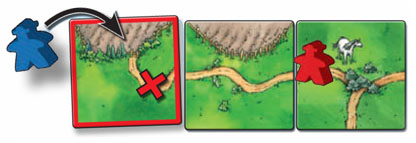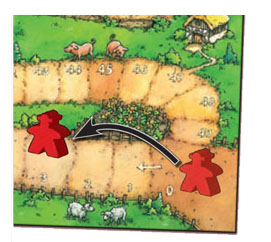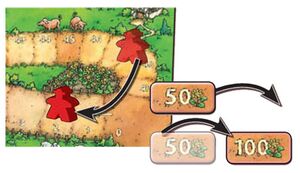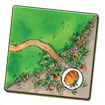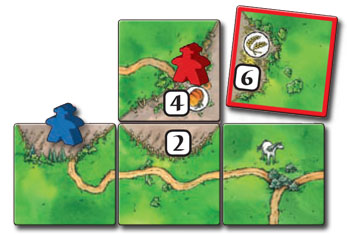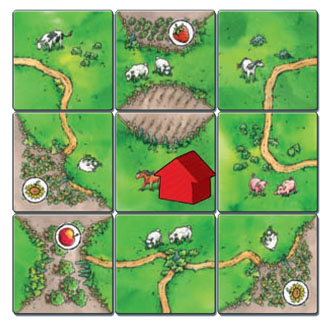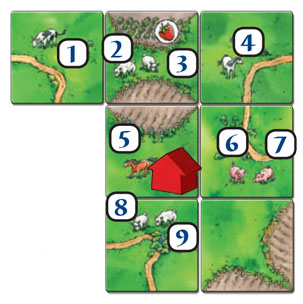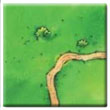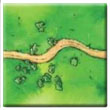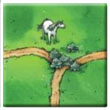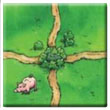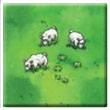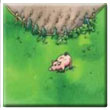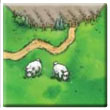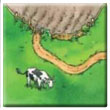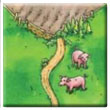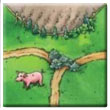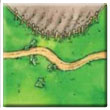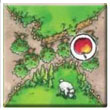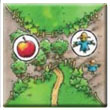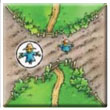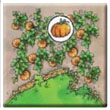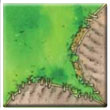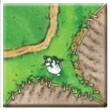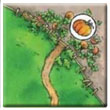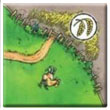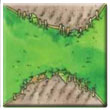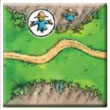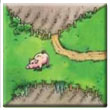Difference between revisions of "Over Hill and Dale Base Game/ro"
(Created page with "=== Ogoarele ===") |
(Created page with "==== Depunerea cartonașelor de teren ====") |
||
| Line 147: | Line 147: | ||
=== Ogoarele === | === Ogoarele === | ||
==== | ==== Depunerea cartonașelor de teren ==== | ||
[[File:OverHillDale_13_FieldPlaceTile.jpg|frameless|right]] | [[File:OverHillDale_13_FieldPlaceTile.jpg|frameless|right]] | ||
Revision as of 22:47, 19 May 2024
Admiră magnifica priveliște a acestui vast mediu rural făcând o drumeție pe un traseu înconjurat de pomi fructiferi, ogoare de cereale și floarea soarelui! Nu vei fi în stare să reziști merelor suculente și căpșunilor dulci pe care le vei găsi pe parcurs. Această nouă variantă rustică a jocului Carcassonne colcăie de decizii interesante și tactici intrigante. Strângerea unei recolte bune, călătoritul în lung și în lat și îngrijirea animalelor tale sunt o răsplată suficientă, dar s-ar putea să foarte bine să te facă să câștigi jocul!
Informații generale și comentarii
Lansat original de Hans im Glück în 2015. A fost lansat cu cutie în limba germană, dar cu reguli traduse în limba română de către Lineart încărcate pe un CD atașat de cutie.
Un jos isteț de plasare a cartonașelor pentru 2 până la 5 jucători, cu vârste de 7 ani în sus.
Componente și configurare
Bun venit la Carcassonne – Peste munți și peste văi! Aceste instrucțiuni te vor îndruma cu blândețe prin regulile cele mai noi variante ale clasicului Carcassonne. După ce citești această scurtă carte de reguli, vei putea să îi înveți jocul pe prietenii tăi și să îl joci cu aceștia. Curând te vei bucura de o nouă experiență reconfortantă Carcassonne.
Mai întâi trebuie să configurezi jocul, dar aceasta este o sarcină simplă. Pe măsură ce te îndrumăm prin configurare, vom explica succint diversele componente.
Cele 73 de cartonașe de teren ilustrează drumuri și ogoare, ce înconjoară pășuni cu vegetație bogată. Pe multe dintre aceste cartonașe sunt găsite de asemenea animale.
Unul dintre cele 73 de cartonașe de teren are un verso albastru. Acesta este cartonașul de pornire, de la care începe fiecare partidă.
Există câte 5 jetoane cu măr, căpșună, dovleac, floarea soarelui și cereale. În plus, există 8 sperietori haioase de ciori.
Plasează cartonașul de pornire în centrul mesei. Amestecă cartonașele rămase cu fața în jos. Apoi desparte-le în mai multe teancuri și plasează-le împrejurul mesei, astfel încât fiecare jucător poate ajunge la un teanc. Sortează jetoanele de recoltă și plasează-le la marginea mesei.
Apoi avem tabla de punctaj, care este și ea plasată la marginea mesei. Lângă ea, plasează cele 5 cartonașe 50/100. Vei avea nevoie de acestea mai târziu, odată ce ai încasat cel puțin 50 de puncte.
Există de 25 de meepleși, câte 5 în culorile galben, roșu, verde, albastru și negru. În plus, în fiecare culoare, există 2 grajduri. Fiecare jucător începe cu 4 meepleși și 2 grajduri. Acestea formează rezerva fiecărui jucător.
Plasează al cincilea meeple de culoarea fiecărui jucător pe căsuța 0 a tablei de punctaj. Toți meepleșii și grajdurile nefolosite de jucători pot fi înapoiate în cutie.
Scopul jocului
Înainte să începem să explicăm regulile: despre ce este mai exact Carcassonne – Peste munți și peste văi? Care este scopul jocului? Tură după tură, jucătorii plasează cartonașe de teren. Făcând asta, construiesc drumuri și ogoare umplute cu fructe și legume.
Meepleșii tăi pot deveni drumeți și țărani, iar tu vei construi grajduri zdravene pe pășuni. Efectuarea acestor lucruri îți va aduce puncte deopotrivă în timpul jocului și la sfârșitul acestuia. La sfârșit, oricine are cele mai multe puncte câștigă!
Să începem!
Desfășurarea jocului
Carcassonne – Peste munți și peste văi este jucat în ordinea acelor de ceasornic. Începe cel mai tânăr jucător. La fel ca fiecare jucător care urmează, jucătorul activ efectuează acțiunile unei ture în ordinea descrisă. Apoi este tura următorului jucător în ordinea acelor de ceasornic, și așa mai departe. Hai să explorăm acțiunile și ordinea în care sunt efectuate acestea. Vom proceda astfel cu cartonașele care ilustrează drumuri, ogoare și animale. Ce acțiuni există?
|
1. Plasează un cartonaș: Un jucător trebuie mereu să tragă exact 1 nou cartonaș de teren și să îl plaseze astfel încât să se conecteze de cel puțin 1 cartonaș de teren plasat anterior. |
2. Pe cartonașul plasat... :
|
3. Încasează puncte:
|
Drumurile
Depunerea cartonașelor de teren
Cartonașul pe care l-ai tras are 3 drumuri care ies dintr-o joncțiune. Îl adaugi peisajului existent
Remarcă că aceste cartonașe de teren se conectează unul de celălalt.
2a. Plasarea unui meeple drept drumeț
Acum că ai plasat cartonașul, ai posibilitatea de a plasa un meeple drept drumeț pe unul dintre drumurile sale. Totuși, ai posibilitatea de a face asta numai dacă nu există deja niciun drumeț pe drum.
Drumul nu este încă finalizat, așa că deocamdată nu se încasează niciun punct (acțiunea 3), iar jocul se duce la următorul jucător în ordinea acelor de ceasornic
Următorul jucător trage un cartonaș de teren și îl plasează. Drumețul tău este deja prezent pe drumul din stânga joncțiunii. Prin urmare, adversarul tău nu are posibilitatea de a plasa propriul său meeple pe acest drum. În schimb, alege să plaseze un meeple drept țăran pe ogorul cartonașului pe care tocmai ce l-a plasat.
Este de obicei bine să plasezi un meeple, dar niciodată obligatoriu. Mereu poți alege să nu plasezi unul.
3. Declanșarea unei evaluări
Ori de câte ori un drum este închis la ambele capete, este evaluat. Drumurile se vor sfârși în joncțiuni sau ogoare sau formând o buclă închisă. Acum verificăm dacă ceva are nevoie să fie evaluat. Ura! Evaluăm drumul, pentru că ambele capete ale acestuia sunt închise.
Nu contează cine a plasat cartonașul, drumul tău este acum finalizat și încasezi puncte pentru el. Câte puncte încasezi? Fiecare cartonaș din drumul tău finalizat îți aduce 1 punct.
Acesta este momentul în care intervine tabla de punctaj. Ori de câte ori încasezi puncte, ții socoteala acestora mutându-ți meepleul de scor înainte. Continuându-ne exemplul, îți mutăm meepleul tău de scor 3 căsuțe înainte.
După fiecare evaluare, meepleul care tocmai ce a fost evaluat este înapoiat în rezerva ta.
Tură după tură, vei încasa din ce în ce mai multe puncte. Odată ce ai terminat un tur de-a lungul tablei de punctaj și ai trecut căsuța 0, ia un cartonaș 50/100 și plasează-l în fața ta cu partea cu 50 în sus. Dacă reușești să faci înconjurul tablei de punctaj o a doua oară, întoarce cartonașul invers pe partea cu 100.
Cu următoarea acțiune, poți încasa chiar și mai multe puncte cu un drum!
3b. Drumeție cu un meeple
În anumite condiții, acum poți porni în drumeție cu meepleul tău.
Unul dintre meepleși tăi trebuie să fie pe un drum. În pasul 1, trebuie să plasezi un cartonaș pentru a extinde un drum. Apoi ai posibilitatea de a face o drumeție pe acest drum cu meepleul tău, dacă și numai dacă nu ai plasat un meeple (sau grajd) în timpul pasului 2.
Alegi o direcție în care să se mute drumețul tău, iar apoi îl faci să facă o drumeție în acea direcție. Încasezi 1 punct pentru fiecare cartonaș peste care se mută drumețul tău.
Făcând asta, meepleul tău poate trece de meepleșii altui jucător. Totuși, meepleul tău nu are posibilitatea de a se opri pe un cartonaș unde există alt drumeț (adică meeple pe un drum). Marchează aceste puncte pe tabla de punctaj.
Reguli importante:
- Nu poți trece de o joncțiune.
- Atunci când plasezi un cartonaș care finalizează un drum (prin urmare declanșând evaluarea), nu ai posibilitatea de a muta un meeple pe acel drum înainte ca evaluarea să aibă loc. Ai posibilitatea de a încasa puncte pentru un drum dat o singură dată pe tură.
- Ai posibilitatea de a porni în drumeție în propria ta tură. Atunci când alt jucător îți extinde drumul, nu ai posibilitatea de a alege să pornești în drumeție.
- Ai posibilitatea de a alege să pornești în drumeție numai cu un singur drumeț pe tură (chiar și atunci când ai extins mai multe drumuri deodată).
Ogoarele
Depunerea cartonașelor de teren
Like always, you draw a tile and place it so that it extends the existing landscape. Naturally, fields must connect to other fields.
2. Placing a meeple as a farmer
Next, check if there is already a meeple in the field. If there aren't any, then you may place a meeple as a farmer in that field.
3. Scoring points
Scoring points for a completed field
On your next turn, you draw this tile. Fortunately, it fits your field perfectly. As luck would have it, it even completes the field.
Whenever a field is completely surrounded by meadow and has no holes, it is considered to be complete. Because you have a meeple in this completed field, you now score points for it. Each tile in the completed field scores 2 points.
Harvest tokens on a completed field
Not only do you score points for a completed field, you also gain Harvest tokens. The Harvest tokens are awarded at the same time as points are.
As the owner of the field, you gain 1 corresponding Harvest token for each harvest symbol in the completed field. You keep these collected Harvest tokens facedown in front of you (of course, you may look at your tokens during the game). You will score points for them at the end of the game.
After you have scored your points and collected your Harvest tokens, you return the meeple in the completed field to your supply.
Please see Multiple meeples on the same feature to read how the tokens are awarded when there are multiple farmers in the same completed field.
The Stables
1. Placing a tile
Like always, you draw a tile and place it so that it extends the existing landscape.
2b. Placing a stable
You begin the game with 2 stables in your supply. Stables can only be placed on a meadow depicted on a tile you just placed. If there are several sections of meadow, you may choose which one to place it on. Don't forget: You must decide between placing a meeple, placing a stable, or hiking with a wanderer. You can only perform one of these three actions.
When placing a stable, you must follow one important rule: you may only place a stable on a tile if none of the 8 tiles surrounding it (orthogonally or diagonally) have a stable on them. This rule is only for stables, not for meeples!
Once a stable is placed, it remains there until the end of the game, at which time it may score you points.
It is recommended that you place stables on and bordering tiles with many animals. Each animal is worth 1 point at the end of the game.
3. Scoring points
No points are scored for stables while the game is being played. Stables are only scored at the end of the game (see Game End and Final Scoring). At that time, players will score 1 point for each animal on the tiles surrounding their stable.
Summary
1. Placing a tile
- The Land tile that you draw must be placed so that it extends the existing landscape (i.e., the illustration).
- In some very rare cases, it may be impossible to place a drawn tile. In those cases, simply place the tile in the box and draw a new one.
2. Placing a meeple or a stable
- You may only place a meeple or stable on the tile you just placed.
- You may not place a meeple/stable in a feature already occupied by another meeple/stable.
- You must follow the important stable placement rule: there may not be a stable on any adjacent tile.
3. Scoring points or hiking with a wanderer
- A path is complete when both ends lead to a junction, a field, or form a closed loop. Each tile in a completed path is worth 1 point.
- You may hike when you extend a path, without completing it, occupied by your own meeple. However, you must not have placed a meeple or stable in the same turn. For each tile that the wanderer hikes to, score 1 point.
- A field is complete when it is completely surrounded by meadow and has no holes. Each tile in a completed field is worth 2 points, and each harvest symbol is worth 1 Harvest token.
- Scoring always occurs at the end of a player's turn. All players with meeples in newly completed features have the opportunity to score points.
- After each scoring, return meeples on completed paths/fields to the players' supplies.
- If there are multiple players in a scored feature, the player with the most meeples is awarded the full points, and all other players score nothing. When more than one player has the most meeples in a scored feature, all tied players score full points.
(Note: How can there be more than one meeple in a feature? To find out, read the examples below.)
Multiple meeples on the same feature
Multiple meeples on a path
Multiple meeples in a field

Distribution of Harvest tokens among multiple farmers
As previously explained, you receive 1 Harvest token for each corresponding harvest symbol in a completed field.
If more than one player has the most farmers in a completed field, then the Harvest tokens are distributed as follows:
- First, gather all the Harvest tokens that will be awarded from their respective supplies.
- Then all players tied for most farmers in that field take turns taking Harvest tokens. Start with the player who placed the tile to complete the field, or (if this player is not one of the tied players) the first tied player clockwise.
- This continues until all the awarded Harvest tokens have been taken. It is possible that some players will receive more Harvest tokens than others.
Game End and Final Scoring
Sadly, all good things must come to an end, and the same is true for Carcassonne – Over Hill and Dale. 'Tis a pity, but now we must determine the winner. The game ends after the turn of the player who placed the last tile. Then we proceed to final scoring, after which the winner will be known to all!
Once the game is over, you score points for the following:
Paths
Each incomplete path is worth 1 point per tile, just like during the game.
Fields
Each incomplete field is worth 1 point per tile, which is half the points. Harvest tokens are not awarded during final scoring!
Stables
For each stable, count the animals on the tile the stable occupies and the 8 tiles that surround it. Count every animal (rooster, cow, horse, sheep, and pig) on these 9 tiles. Each animal is worth 1 point.
Harvest Tokens
Each Harvest token is worth 1 point (even the scarecrow). In addition, each set of 5 different fruit tokens (1 each of apple, strawberry, pumpkin, sunflower, and grain) is worth an additional 5 points. Scarecrows may be used as wild tokens, replacing any 1 fruit in a set.
The Winner
Move your scoring meeple forward on the scoreboard to mark the points you are awarded during final scoring.
Whoever has scored the most points is the winner!
If there is a tie for the most points, the players rejoice in a shared victory! Congratulations!
Ansamblul cartonașelor
Cartonașe obișnuite totale: 73
Notă: Cartonașele cu mai multe versiuni au diverse distribuții de animale și simboluri de recoltă.
Note de subsol
Pentru licențierea și semnificația pictogramelor te rugăm să vizitezi Pagina pictogramelor.
